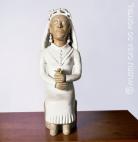NEARBY LOCATIONS
LOCAL ARTISTS
WORKED THEMES
Santana do Araçuaí - MG
Santana do Araçuaí is a district of the small municipality of Ponto dos Volantes, which has an estimated population of 11,408 (IBGE, CNM, 2011). The municipality is located in Jequitinhonha Valley, around 600km from the state capital Belo Horizonte. Situated in Northeast Minas Gerais the wide Jequitinhonha river basin is classified by the local population as Upper, Middle and Lower valley. From the geo-cultural viewpoint, and considering the geo-environmental and historic-cultural differences of the Valley, the division between the Upper and Lower Jequitinhonha is considered sufficient by some researchers since the Middle and Lower Valleys have a unity of biomes and settlement. From this perspective, Santana do Araçuaí is situated in the Lower Jequitinhonha valley. The official history of Ponto dos Volantes is recent, dating from 1995 when the municipality was emancipated. It was only in the 1940s that the municipality´s population increased when the federal highway BR-116 between Rio de Janeiro and Bahia was built. The district of Santana do Araçuaí was the route of the sections that allowed access to a number of nearby towns due to its location at the “junction of the road between the Lower and Middle Jequitinhonha valleys”. So the settlement was concentrated there and the village became the trading centre of the region (IBGE, 2011). According to Fraga and Lima (2012: 7), “the ‘discovery’ of the handicraft as a source of income” dates from the second half of the 20th century when “more effective economic and social development actions in the region” were taken. External factors boosted a transition from utility production to what was considered art, focusing on external consumers. The “figures” chosen as the symbol of the art women from Jequitinhonha, are an example of “a relatively recent cultural process” (Mascelani, 2008:77). Santana de Araçuaí became known precisely because of the figure-making “and experiments with new pigments in painting”. Also worth mention is the artist known as Teca who preferred to work modelling such figures. Maurina Pereira dos Santos was born in 1946 in the district’s vicinity. When she moved there more than 35 years ago with the idea of studying, she learned to work the clay. At first her neighbour Placidina do Nascimento initiated her in this art and, when she died, Dona Izabel became her teacher. Teca transmitted her knowledge of clay to her daughter and daughter-in-law and her work is to be found in the collection of the Casa do Pontal Museum in Rio de Janeiro (Mascelani, 2008).

